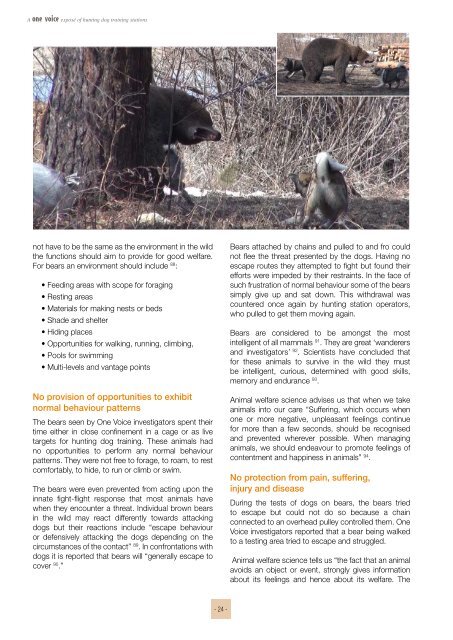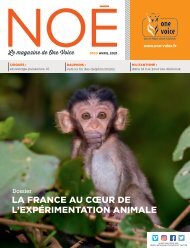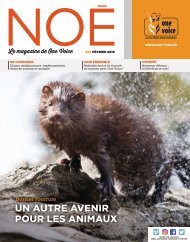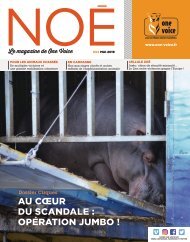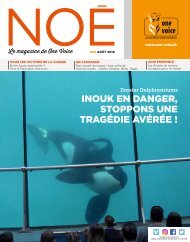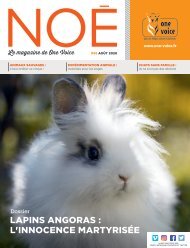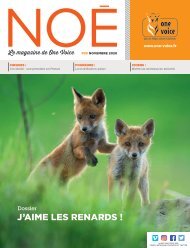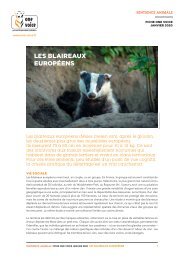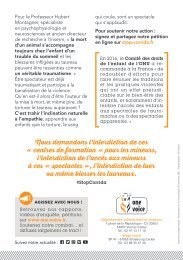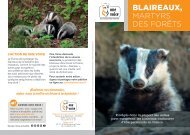The baiting of wild animals in Russia
You also want an ePaper? Increase the reach of your titles
YUMPU automatically turns print PDFs into web optimized ePapers that Google loves.
A<br />
exposé <strong>of</strong> hunt<strong>in</strong>g dog tra<strong>in</strong><strong>in</strong>g stations<br />
not have to be the same as the environment <strong>in</strong> the <strong>wild</strong><br />
the functions should aim to provide for good welfare.<br />
For bears an environment should <strong>in</strong>clude 88 :<br />
• Feed<strong>in</strong>g areas with scope for forag<strong>in</strong>g<br />
• Rest<strong>in</strong>g areas<br />
• Materials for mak<strong>in</strong>g nests or beds<br />
• Shade and shelter<br />
• Hid<strong>in</strong>g places<br />
• Opportunities for walk<strong>in</strong>g, runn<strong>in</strong>g, climb<strong>in</strong>g,<br />
• Pools for swimm<strong>in</strong>g<br />
• Multi-levels and vantage po<strong>in</strong>ts<br />
No provision <strong>of</strong> opportunities to exhibit<br />
normal behaviour patterns<br />
<strong>The</strong> bears seen by One Voice <strong>in</strong>vestigators spent their<br />
time either <strong>in</strong> close conf<strong>in</strong>ement <strong>in</strong> a cage or as live<br />
targets for hunt<strong>in</strong>g dog tra<strong>in</strong><strong>in</strong>g. <strong>The</strong>se <strong>animals</strong> had<br />
no opportunities to perform any normal behaviour<br />
patterns. <strong>The</strong>y were not free to forage, to roam, to rest<br />
comfortably, to hide, to run or climb or swim.<br />
<strong>The</strong> bears were even prevented from act<strong>in</strong>g upon the<br />
<strong>in</strong>nate fight-flight response that most <strong>animals</strong> have<br />
when they encounter a threat. Individual brown bears<br />
<strong>in</strong> the <strong>wild</strong> may react differently towards attack<strong>in</strong>g<br />
dogs but their reactions <strong>in</strong>clude “escape behaviour<br />
or defensively attack<strong>in</strong>g the dogs depend<strong>in</strong>g on the<br />
circumstances <strong>of</strong> the contact” 89 . In confrontations with<br />
dogs it is reported that bears will “generally escape to<br />
cover 90 .”<br />
Bears attached by cha<strong>in</strong>s and pulled to and fro could<br />
not flee the threat presented by the dogs. Hav<strong>in</strong>g no<br />
escape routes they attempted to fight but found their<br />
efforts were impeded by their restra<strong>in</strong>ts. In the face <strong>of</strong><br />
such frustration <strong>of</strong> normal behaviour some <strong>of</strong> the bears<br />
simply give up and sat down. This withdrawal was<br />
countered once aga<strong>in</strong> by hunt<strong>in</strong>g station operators,<br />
who pulled to get them mov<strong>in</strong>g aga<strong>in</strong>.<br />
Bears are considered to be amongst the most<br />
<strong>in</strong>telligent <strong>of</strong> all mammals 91 . <strong>The</strong>y are great ‘wanderers<br />
and <strong>in</strong>vestigators’ 92 . Scientists have concluded that<br />
for these <strong>animals</strong> to survive <strong>in</strong> the <strong>wild</strong> they must<br />
be <strong>in</strong>telligent, curious, determ<strong>in</strong>ed with good skills,<br />
memory and endurance 93 .<br />
Animal welfare science advises us that when we take<br />
<strong>animals</strong> <strong>in</strong>to our care “Suffer<strong>in</strong>g, which occurs when<br />
one or more negative, unpleasant feel<strong>in</strong>gs cont<strong>in</strong>ue<br />
for more than a few seconds, should be recognised<br />
and prevented wherever possible. When manag<strong>in</strong>g<br />
<strong>animals</strong>, we should endeavour to promote feel<strong>in</strong>gs <strong>of</strong><br />
contentment and happ<strong>in</strong>ess <strong>in</strong> <strong>animals</strong>” 94 .<br />
No protection from pa<strong>in</strong>, suffer<strong>in</strong>g,<br />
<strong>in</strong>jury and disease<br />
Dur<strong>in</strong>g the tests <strong>of</strong> dogs on bears, the bears tried<br />
to escape but could not do so because a cha<strong>in</strong><br />
connected to an overhead pulley controlled them. One<br />
Voice <strong>in</strong>vestigators reported that a bear be<strong>in</strong>g walked<br />
to a test<strong>in</strong>g area tried to escape and struggled.<br />
Animal welfare science tells us “the fact that an animal<br />
avoids an object or event, strongly gives <strong>in</strong>formation<br />
about its feel<strong>in</strong>gs and hence about its welfare. <strong>The</strong><br />
- 24 -


